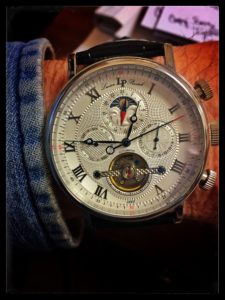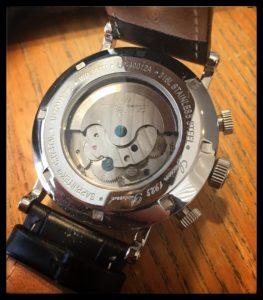 I love this watch. Lucien-Picard, moonphase, automatic. As watches go, it’s not super expensive, but it’s not a cheapo watch either. I just like the look of the face so much, with the little skeleton window onto the complication, and the moonphase window with it’s rotating dial with sun and moon.
I love this watch. Lucien-Picard, moonphase, automatic. As watches go, it’s not super expensive, but it’s not a cheapo watch either. I just like the look of the face so much, with the little skeleton window onto the complication, and the moonphase window with it’s rotating dial with sun and moon.
It makes me feel good to wear it. If that makes me shallow or vain, so be it.
I wore it every day for a long while when I first got it.
Then, sadly, it stopped working.
Looking through the window on the backside, what I saw was that the rotor had come loose and was flopping around in there.
What that ALSO meant was that there was a loose screw or pin inside that was in danger of falling into the delicate gears and permanently damaging the watch.
Damn.
An “Automatic” watch is what was marketed a number of decades ago as a “self winding” watch. The rotor is the spinning weight that winds the mainspring and keeps the complication humming along.
 The rotor spins freely all day based just on the normal motion of your wrist as you go through your daily activities.
The rotor spins freely all day based just on the normal motion of your wrist as you go through your daily activities.
The problem, of course, is that the rotor (and therefore the entire winding mechanism) continues to spin even after the mainspring is fully wound. This leads to several potential problems. possibly breaking the mainspring. Causing the balance wheel to oscillate with excessive amplitude which leads to EITHER the watch running too fast, OR to breaking the tiny impulse pin.
Adrien Phillipe, one of the founders of Patek-Phillippe, invented an ingenious mechanical method, back in the mid 1800’s, of incorporating a slipping differential spring or “bridle” that prevents the mainspring from being over-wound. This allowed the advent of the first viable “automatic” watches. But they were very, very expensive for the average consumer.
Hence the iconic image of the railroad conductor pulling out his pocket watch, winding it by twisting the stem, and putting it back in his vest watch pocket. MOST watches were, for a long, long while, watches that required you to wind them manually every day. The more you kept it wound up full, the better time it kept.
I had a stem-winding watch back as a kid. A wrist watch. Timex. You too? If you’re as old or older than me, I bet you did. It became habit to wind them first thing in the morning, or at night before you turned in for the evening.
The self-winders though, started being very common (and relatively inexpensive) in the mid-1960s. Then not long afterward, the digital watches came along. First with the red LED displays that ate batteries. Later with the LCD’s that were more power efficient. And also in that same time-frame, we saw the introduction of the electronic quartz watch with its internal battery. (Seiko being the first to bring the quartz watches to the mass market. With a quartz watch, you wear if for months and months until the battery dies, then take to any numbskull with a pry-tool who can replace the battery.) If you’re not wearing a digital watch, a smart watch, or a nice automatic, you’re most likely wearing a quartz. By far the most common mechanical movement watch today.
But the automatics have a mystique and a beauty that speaks to me …. and a design elegance that I find appealing.
So I mourned the “passing” of my Lucien-Picard, and I carefully laid the watch aside and started wearing other watches.
There are few, if any, good watch repair shops around. It’s a lost art, and those “old guys” who knew what they were doing with these tiny, delicate, mechanisms are dying off, retiring and closing up shop, or dedicating themselves ONLY to the repair of VERY expensive watches. (Rolex, Patek-Phillippe, IWC, etc.) If you can afford a $10k watch, you’re likely willing to spend a hundred or a few hundred on a repair if it needs it. Not so much with a far less expensive mechanical watch.
So my Lucien-Picard languished in a drawer.
 However ….. I am my father’s son.
However ….. I am my father’s son.
He never met anything he couldn’t fix. Or, at least TRY to fix
If something’s not working, take it apart, pay attention to how it went together, see how it works, and figure out WHY it’s NOT working! Use some common sense and reasoning. Then fix the damn thing.
As simple as that. As complicated as that.
I sat at the kitchen table, or out in his workshop so often as a boy, watching him work on things that were either ours, some family members, or maybe just a friend who had dropped off a radio that didn’t play, a fan that didn’t oscillate, or whatever. I asked a lot of questions. He always patiently answered them. Those are some of my best memories of times with him, among a lifetime of precious memories.
I have often felt a small sense of shame when I pitch something away that doesn’t work. Because I know my dad would have tackled the repair.
But that’s not the culture we live in anymore, is it? Your doo-dad gizmo gee-haw whimmy-diddle doesn’t work? The landfill is filled to overflowing with those, man. Pitch it! Go buy a new one. Walmart’s got them on sale this week.
So that non-functioning Lucien-Picard continued to sit in my drawer. But it gnawed at my insides. I could feel it taunting me.
Damn it … if there’s a screw or a pin or some combination thereof rattling around loose inside, below or beside the loose rotor, I should be able to find it, right? With enough light, a magnifier, and tiny tweezers I *should* theoretically be able to find it, extract it, re-position the rotor, and re-affix the pivot point.
So, I bought a tool kit with an inexpensive watch case-back removal wrench …. I LOVE specialty tools!! …. I disassembled the watch, took out the rotor, found the culprit, and repaired the watch.
It works.
This “watch repairman” is proud of himself. The watch repairman’s father would be even prouder. I can feel it in my bones, and I am smiling along with him.
Its 1:37 pm on a Saturday, dad. I know that because my watch works.
I wish I could give you a call.
Love,
John

One Comment
Leave a reply →